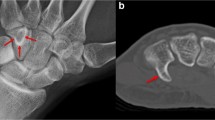Abstract
Background
Cuboid fractures are rare, usually occult on initial radiographs and are often underdiagnosed. MRI is more sensitive than radiographs for detecting acute, non-displaced cuboid fractures in adults, but only case reports have described these findings in children.
Objective
To summarize the MR and clinical features of cuboid fractures and compare MR findings with initial and follow-up radiographs in a cohort of children.
Materials and methods
A retrospective search for patients <18 years of age with cuboid fractures was performed during a 10-year period at a large tertiary children’s hospital. Subjects with cuboid fractures reported on MRI and available clinical history were included. MR images were evaluated for fracture location, fracture morphology, percentage of marrow edema in the cuboid, subchondral disruption, and associated tendon or ligamentous injury. Initial and short-term follow-up radiographs were also reviewed when available.
Results
Nineteen children ages 18 months to 17 years (mean: 9.0 years, standard deviation: 4.1 years, 63% boys) were diagnosed with cuboid fractures by MRI. Most cases of cuboid fractures are related to acute trauma (63%) but can be seen as stress fractures (16%). Most fractures (17/19, 89%) were linear in configuration. Fractures were most commonly adjacent to the tarsometatarsal joint (10/19, 52%). The degree of marrow edema was variable. Ligamentous injury was seen in two patients and tendon pathology was seen in one, all adolescents. Initial radiographs (n=10) were negative in 9 cases (90%). All available follow-up radiographs (n=12, obtained 19–42 days after MRI) demonstrated sclerosis in the region of the fracture.
Conclusion
MR-depicted cuboid fractures in children typically occur in isolation. The fractures were most commonly adjacent to the tarsometatarsal joint and linear in morphology. Initial radiographs were usually normal and follow-up radiographs depicted sclerosis at the site of fracture in all available cases.



Similar content being viewed by others
References
Pierre-Jerome C, Reyes EJ, Moncayo V et al (2012) MRI of the cuboid bone: analysis of changes in diabetic versus non-diabetic patients and their clinical significance. Eur J Radiol 81:2771–2775
Senaran H, Mason D, De Pellegrin M (2006) Cuboid fractures in preschool children. J Pediatr Orthop 26:741–744
Sadineni RT, Pasumarthy A, Bellapa NC, Velicheti S (2015) Imaging patterns in MRI in recent bone injuries following negative or inconclusive plain radiographs. J Clin Diagn Res 9:TC10–TC13
Englaro EE, Gelfand MJ, Paltiel HJ (1992) Bone scintigraphy in preschool children with lower extremity pain of unknown origin. J Nucl Med 33:351–354
Yu SM, Dardani M, Yu JS (2013) MRI of isolated cuboid stress fractures in adults. AJR Am J Roentgenol 201:1325–1330
Joo SY, Jeong C (2015) Stress fracture of tarsal cuboid bone in early childhood. Eur J Orthop Surg Traumatol 25:595–599
Miller TT, Pavlov H, Gupta M et al (2002) Isolated injury of the cuboid bone. Emerg Radiol 9:272–277
Kolker D, Marti CB, Gautier E (2002) Pericuboid fracture-dislocation with cuboid subluxation. Foot Ankle Int 23:163–167
Borrelli J Jr, De S, VanPelt M (2012) Fracture of the cuboid. J Am Acad Orthop Surg 20:472–477
Dodson NB, Dodson EE, Shromoff PJ (2008) Imaging strategies for diagnosing calcaneal and cuboid stress fractures. Clin Podiatr Med Surg 25:183–201 vi
Yu JS, Solmen J (2001) Stress fractures associated with plantar fascia disruption: two case reports involving the cuboid. J Comput Assist Tomogr 25:971–974
Mayr J, Peicha G, Grechenig W et al (2006) Fractures and dislocations of the foot in children. Clin Podiatr Med Surg 23:167–189 ix
Hermel MB, Gershon-Cohen J (1953) The nutcracker fracture of the cuboid by indirect violence. Radiology 60:850–854
Bahel A, Yu JS (2010) Lateral plantar pain: diagnostic considerations. Emerg Radiol 17:291–298
Ceroni D, De Rosa V, De Coulon G, Kaelin A (2007) Cuboid nutcracker fracture due to horseback riding in children: case series and review of the literature. J Pediatr Orthop 27:557–561
Franco M, Albano L, Kacso I et al (2005) An uncommon cause of foot pain: the cuboid insufficiency stress fracture. Joint Bone Spine 72:76–78
Hunter JC, Sangeorzan BJ (1996) A nutcracker fracture: cuboid fracture with an associated avulsion fracture of the tarsal navicular. AJR Am J Roentgenol 166:888
Williams DP, Hanoun A, Hakimi M et al (2009) Talonavicular dislocation with associated cuboid fracture following low-energy trauma. Foot Ankle Surg 15:155–157
Holbein O, Bauer G, Kinzl L (1998) Fracture of the cuboid in children: case report and review of the literature. J Pediatr Orthop 18:466–468
Hsu JC, Chang JH, Wang SJ, Wu SS (2004) The nutcracker fracture of the cuboid in children: a case report. Foot Ankle Int 25:423–425
Nicastro JF, Haupt HA (1984) Probable stress fracture of the cuboid in an infant. A case report. J Bone Joint Surg Am 66:1106–1108
Stalder H, Zanetti M (2000) Stress fracture of the cuboid in an 8-year-old boy: a characteristic magnetic resonance imaging diagnosis. Arch Orthop Trauma Surg 120:233–235
Blumberg K, Patterson RJ (1991) The toddler's cuboid fracture. Radiology 179:93–94
Simonian PT, Vahey JW, Rosenbaum DM et al (1995) Fracture of the cuboid in children. A source of leg symptoms. J Bone Joint Surg (Br) 77:104–106
Acknowledgments
This abstract was presented at the Society for Pediatric Radiology 2017 meeting in Vancouver, British Columbia, Canada.
Author information
Authors and Affiliations
Corresponding author
Ethics declarations
Conflicts of interest
None.
Rights and permissions
About this article
Cite this article
O’Dell, M.C., Chauvin, N.A., Jaramillo, D. et al. MR imaging features of cuboid fractures in children. Pediatr Radiol 48, 680–685 (2018). https://doi.org/10.1007/s00247-018-4076-1
Received:
Revised:
Accepted:
Published:
Issue Date:
DOI: https://doi.org/10.1007/s00247-018-4076-1




